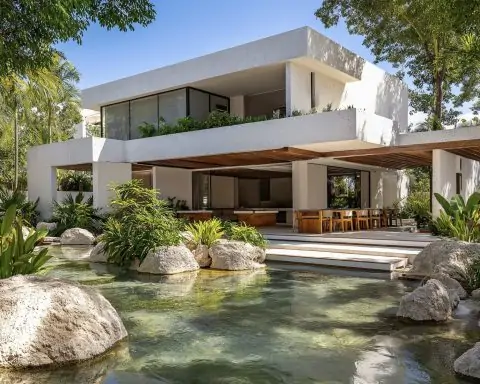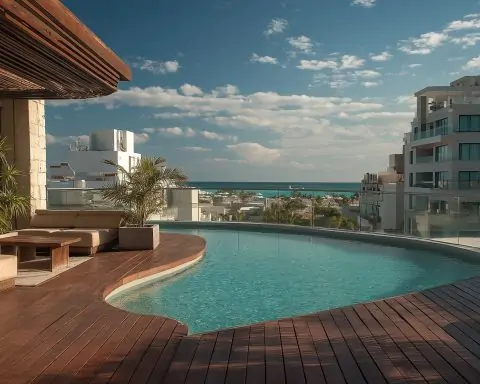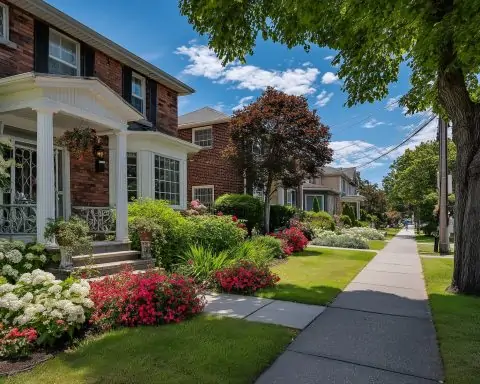Key Facts
- U.S. mortgage relief: The average 30-year fixed mortgage rate hit an 11-month low (~6.5%) realestatenews.com, easing monthly payments slightly. However, buyer demand remains subdued – applications fell 1.2% in late August despite the rate dip realestatenews.com realestatenews.com. “House hunters are on rate watch, hoping [rates] drop below 6%,” noted one Seattle agent realestatenews.com.
- China’s fragile recovery: China’s housing downturn persists, but 2025 home price declines are now forecast at 3.8% (less severe than the 4.8% fall expected earlier) reuters.com. Analysts warn property sales and investment will contract more sharply than thought reuters.com, and some call for “direct intervention” by Beijing to stabilize the market reuters.com.
- Europe cooling off: UK house prices slipped 0.1% in August – an unexpected dip as stretched affordability and 35% of income now needed for a first-time buyer’s mortgage weigh on demand reuters.com. The eurozone construction sector remains in a slump (PMIs <50 in Germany, France, Italy) riotimesonline.com, signaling weaker development activity across the continent.
- Asia-Pacific mixed: Hong Kong’s property market is bottoming out, with its largest developer seeing profit rise for the first time in 3 years amid relaxed mortgage rules chinadailyhk.com chinadailyhk.com. Japan’s economy is a bright spot – July household spending rose 2.2% and wages 3.0% riotimesonline.com – potentially supporting housing demand, even as China’s woes cast a regional shadow.
- Middle East boom: Gulf real estate surges ahead. Dubai’s property sales jumped 40% in H1 2025 (AED 326.6 billion vs 233 billion a year prior) wam.ae, fueled by foreign investors and oil-led growth. Some UAE projects are selling out in “one or two weeks” despite three-year build times wam.ae. Saudi Arabia presses forward with mega-projects like NEOM to meet ambitious 2030 housing targets english.aawsat.com english.aawsat.com.
- Latin America challenges: Brazil’s housing market is squeezed by sky-high interest rates (~14.75% Selic) that drained mortgage funding reuters.com. The central bank is devising a new “bridge” financing model to cope reuters.com. Mexico’s construction outlook is weak – gross fixed investment fell 6.4% YoY riotimesonline.com – reflecting caution despite hopes for nearshoring-led growth.
- Africa’s housing crunch: Severe home shortages persist – Nigeria’s deficit is ~28 million units businessamlive.com – even as Africa’s real estate market is forecast to total $17.6 trillion by 2025 businessamlive.com. South Africa enjoys relatively better affordability (price-to-income ~3.1 vs ~10 in Nigeria) businessamlive.com, and recent interest rate cuts there (prime ~10.75%) are sparking buyer activity in mid-tier segments.
North America
Residential & Housing Markets
Mortgage rates and buyer sentiment: U.S. mortgage costs have eased for seven straight weeks, offering slight relief to buyers. The 30-year fixed rate now averages 6.5% – the lowest in 11 months realestatenews.com, thanks to cooling inflation and anticipation of Federal Reserve rate cuts. “Historically, a weaker-than-expected jobs report fuels optimism for Fed cuts and can lower bond yields, thereby nudging mortgage rates downward,” explained Hannah Jones, an analyst at Realtor.com realestatenews.com. Conversely, strong jobs data could send rates back up, she noted, underscoring “volatility ahead” realestatenews.com. With a pivotal U.S. employment report due, market watchers are braced for rate swings.
Buyer demand and prices: Even with lower rates, homebuyer demand remains lukewarm. “Homebuyers…should not be trying to time rates,” advises Bright MLS chief economist Lisa Sturtevant, urging buyers to capitalize on rising inventory and more flexible sellers instead realestatenews.com. Indeed, active U.S. listings are up ~11% from last year as more owners list and price growth moderates realestatenews.com. Many sellers have started cutting prices or offering concessions to make deals realestatenews.com. As a result, the median monthly payment dipped to its lowest since January (≈$2,593) realestatenews.com. But that’s still 5% higher than a year ago and double pre-pandemic levels realestatenews.com, highlighting affordability strains. “Mortgage rates haven’t come down significantly enough to bring back a flood of buyers. House hunters are…hoping they’ll drop below 6%,” said Mariah O’Keefe, a Redfin agent in Seattle realestatenews.com. On the pricing front, the U.S. housing market remains resilient overall – national median prices are roughly flat to last year, with no sign of a 2025 crash forbes.com – but regional variations are growing. High-cost West Coast markets have seen slight declines, while some Midwest and Northeast cities still notch modest gains amid solid local economies.
Market risks and regional disparities: A new housing risk report from ATTOM ranked parts of California and Florida as most vulnerable to a downturn this year worldpropertyjournal.com. These markets face a perfect storm of poor affordability (over 50% of wages for a median home), rising foreclosures, and above-average unemployment worldpropertyjournal.com worldpropertyjournal.com. “This summer’s home prices were certainly eye-catching, but…key indicators beyond just sales price [offer] a barometer of where the market is headed,” said ATTOM CEO Rob Barber worldpropertyjournal.com. By contrast, many Texas and Midwest housing markets look healthier, with lower unemployment and few underwater loans worldpropertyjournal.com. Canada, meanwhile, is at an inflection point: after a prolonged freeze, buyer sentiment is cautiously improving. Canadian mortgage rates have stabilized around ~5.5% for 5-year fixed loans fortune.com, and the Bank of Canada is widely expected to begin cutting rates at its Sept. 17 meeting to spur growth ca.finance.yahoo.com. Toronto’s housing board reported a slight uptick in August sales (+2.3% YoY) as prices soften, signaling a “stalled recovery” might be turning a corner trreb.ca. Still, affordability in Canada remains stretched, with average home prices (~C$673k) up ~0.6% from a year ago stats.crea.ca and households near record debt levels.
Multifamily and rents: The U.S. apartment rental market is softening after years of expansion. National occupancy ticked down to 95.4% in August and effective rents fell 0.2% year-over-year, the first annual rent decline since early 2021 credaily.com credaily.com. This mild dip reflects a wave of new supply in Sun Belt cities and tenants squeezed by inflation. Rent cuts are concentrated in overbuilt metros like Austin, Phoenix, and Orlando, and in tourist-dependent markets (e.g. Las Vegas) where landlords report weaker demand credaily.com credaily.com. In contrast, some high-cost coastal cities are still seeing rents climb 3–7% YoY – San Francisco, New York, San Jose – as limited supply and strong job markets keep upward pressure credaily.com. The overall cooling is welcome news for renters, but experts note it’s a rebalancing rather than a crash. “Although monthly rent growth has been limited for over a year, this marks a shift into negative territory,” observed RealPage analysts in a market update credaily.com. With more apartment projects completing into 2026, renters may finally regain some bargaining power.
Commercial & Industrial Real Estate
Office sector and commercial deals: North America’s office markets continue to face stress from high vacancies and refinancing challenges. In the U.S., office vacancy sits around 18–20% in many downtowns bisnow.com, and landlords are resorting to heavy discounts or repurposing buildings. This week saw an example of distressed office sales: private investor Savanna acquired a Midtown Manhattan office tower (444 Madison Ave) via short-sale for $50 million crenews.com – a steep discount reflecting lowered values. On the West Coast, one San Francisco office property was bought for conversion into housing, as investors eye creative reuses for underfilled towers crenews.com. “Office attendance remains lagging,” warned one industry outlook, forcing landlords to fund costly upgrades and concessions to lure tenants realestatenews.com. Leasing activity is subdued, though some brokers claim the worst may be over. In Los Angeles, for instance, office investment doubled from a low base in Q2, and local brokers say the market “has hit bottom” with opportunistic buyers emerging bisnow.com. Still, any office recovery is expected to be slow and uneven through 2025.
Industrial and logistics: In contrast, industrial real estate remains a powerhouse. Data centers in North America just hit a “historic low” vacancy rate as cloud computing demand soars crenews.com. Warehouse and logistics space also stays tight – national industrial vacancies hover around 4% and rents are rising, especially near ports and big cities wam.ae wam.ae. Investors poured over $33 billion into industrial properties in H1 2025 credaily.com, sensing durable e-commerce and manufacturing needs. For example, in California, an investor secured a $67 million loan for a fully leased Sacramento industrial park, underscoring confidence in the sector crenews.com crenews.com. Developers are ramping up new projects where they can: in Dallas, a year-old modern warehouse traded to a REIT at high valuation crenews.com, and construction of mega distribution centers continues in Sun Belt hubs. “The industrial sector continues to attract international investors,” notes CBRE’s Q2 report, which cites “strong rental growth in key logistics assets” in markets like Atlanta and Toronto wam.ae. One potential headwind: if consumer spending or trade volumes falter, the breakneck pace of rent growth may moderate. But for now, industrial real estate is a standout performer globally.
Retail and mixed-use: The retail real estate picture is nuanced. Storefront vacancies in the U.S. sit near record lows (~5.3% availability) despite waves of chain closures marketsgroup.org. Well-located shopping centers and high-street retail have largely backfilled pandemic-era vacancies, and foot traffic is rebounding in many malls. However, a new report by Newmark shows retail leasing volume plummeted 29% year-on-year in Q2 2025 marketsgroup.org. Only 31.7 million sq. ft. was leased nationwide – 23% below the long-term average – as retailers grew cautious amid economic uncertainty and a scarcity of prime space marketsgroup.org. Store closures outpaced openings, tipping net absorption negative last quarter marketsgroup.org. High-profile bankruptcies (Joann, Rite Aid, Forever 21) and cost-cutting by major chains contributed to the pullback marketsgroup.org. “Many retail operators are streamlining store fleets…focusing on underperforming locations,” the report noted, predicting more consolidation through 2026 marketsgroup.org. Yet, even as big boxes shrink, retail fundamentals are far from collapse – availability remains tighter than the 6.6% historical average marketsgroup.org and asking rents are holding steady overall. Grocery-anchored centers and luxury retail corridors are performing especially well, while secondary malls struggle. In Canada, similarly, top-tier malls in Toronto and Vancouver report high occupancies and rent growth, even as some mid-market retailers retrench. Mixed-use developments that blend retail, dining, and entertainment are emerging as a savior for aging malls, with several large U.S. mall-to-apartment conversion projects announced in the past year to revive foot traffic.
Land & Development
Construction and land sales: Construction activity is bifurcated across North America. Homebuilding in the U.S. has slowed from 2022’s highs – single-family housing starts are down modestly, and builders cite difficulty finding affordable land. In a NAHB survey, 38% of builders said lot supply was “low” in their markets eyeonhousing.org. However, new home sales are only ~3% lower year-to-date kitchenbathdesign.com, indicating builders are managing to sell homes albeit with incentives. Land prices remain elevated in many regions, which, coupled with high material costs, keeps pressure on new home prices. In Canada, developers are cautiously resuming projects after a lull, helped by government measures like Vancouver’s permitting reforms and a new Toronto initiative to convert underused offices into housing. Infrastructure and land development tied to industrial uses – like megasite preparations for battery factories in the U.S. South, or warehouse parks in Mexico’s north – are hot spots attracting institutional capital. For instance, Mexico is marketing new industrial zones near the U.S. border to capture reshoring, though local infrastructure gaps persist. Farmland and timberland, as alternative real assets, have also seen increased investor interest in 2025 amid volatile stock markets, with several large land portfolio sales reported over the summer. Overall, while North America’s development pipeline has thinned compared to the post-COVID boom, strategic projects (especially in affordable housing and logistics) continue to move forward, often backed by public-private partnerships and creative financing.
Europe
Residential Real Estate
Housing prices and policy: Europe’s housing markets are showing signs of cooling after years of growth. In the UK, Nationwide’s latest index shocked observers by revealing a 0.1% drop in house prices in August (vs. July) reuters.com – the third monthly decline since April. Annual price growth slowed to just 2.1%, the weakest since mid-2024 reuters.com. “The relatively subdued pace of house price growth is understandable given that affordability remains stretched,” said Nationwide’s Chief Economist Robert Gardner reuters.com. Despite the Bank of England cutting its benchmark rate to 4.0% in August reuters.com (the first cut in the cycle), borrowing costs are still high by recent standards and the average buyer’s mortgage now eats up ~35% of take-home pay reuters.com. Would-be buyers also face uncertainty over potential tax changes – speculation about a new “mansion tax” in the next budget has dented buyer confidence at the upper end. “The risk is that speculation over property tax rises…hits buyer sentiment further,” warned Ashley Webb of Capital Economics reuters.com. On the Continent, house price growth has largely stalled in many countries. Germany is witnessing slight nominal price declines in some cities as an era of ultra-cheap mortgages ends. Sweden and Denmark saw sharper corrections earlier (10–15% off peaks) but appear to be stabilizing as interest rates plateau. In France, prices are flat overall but transactions have slowed, prompting the government to consider buyer incentives for new eco-friendly homes. Poland and Central Europe have pockets of growth (driven by strong wage gains and Ukrainian immigration in Poland’s case), yet high eurozone rates curb financing. Broadly, Europe’s housing is entering a period of price stagnation – a relief for first-time buyers, but a challenge for developers and recent owners who budgeted for endless appreciation.
Rents and affordability: Renters across Europe are feeling the squeeze. In many capitals – London, Dublin, Paris, Berlin – rents have hit record highs this year, fueled by limited supply and higher landlord costs. For example, London’s average rent surpassed £2,200/month, up ~12% annually, as higher mortgage rates pushed some landlords to sell or raise rents. Some governments are intervening: Ireland extended its rent cap and eviction ban in sensitive markets, while Scotland maintains temporary rent freeze measures for existing tenants. Germany is expanding its social housing budget after surveys showed a drastic shortage of affordable units. On the flip side, a few cities face oversupply pressures: Dubai-like construction booms in parts of Spain’s Costa del Sol and Portugal’s Algarve (popular with expats) have actually begun to slightly lower luxury rents there, an outlier in Europe. The overall European homeownership rate has dipped as younger households rent longer, a trend policymakers are watching closely. In the UK, the private rent component of CPI is running ~5% higher year-on-year, the fastest in over a decade, contributing to inflation. This has spurred debates about stronger rent control versus measures to boost rental supply. Notably, Poland just implemented incentives for build-to-rent developments and Austria is channeling pension funds into affordable housing bonds – innovative approaches to ease Europe’s rental housing crunch.
Commercial & Industrial Property
Construction and development slump: Europe’s construction and development sector is firmly on the back foot. The eurozone construction PMI sunk deeper below the 50 mark in August, signaling contraction: Germany’s index fell to 46.0, Italy’s to 47.7, and France held at 46.7 riotimesonline.com. This marks a sustained downturn in building activity. High financing costs, labor shortages, and economic uncertainty are leading many projects to be postponed or canceled. From offices in Frankfurt to residential projects in Madrid, developers report difficulty securing profitable yields with ECB interest rates at 4%. Even as input costs (like lumber and steel) have eased from 2022 peaks, developer sentiment remains weak. In Germany, building permits for housing were down ~27% in the first half of 2025 year-on-year, and industry groups warn of a “developer shakeout” unless borrowing costs fall. Sweden’s construction crisis is acute – several major construction firms have filed for bankruptcy protection this year amid a glut of unsold units and expensive debt. Infrastructure and industrial projects, however, are a relative bright spot: EU-funded green energy and semiconductor fabs (in Germany and France) and windfarm projects (North Sea) are moving ahead, providing some construction jobs. But overall, Europe’s developers are in retrenchment. This decline in construction is both a symptom and a cause of economic fragility in Europe – fewer cranes on the skyline today could mean tighter housing supply (and higher rents) in a few years if and when demand recovers.
Office and retail markets: European office markets remain bifurcated. Prime, modern office spaces in cities like London and Paris are holding value as companies flight-to-quality, but older, less efficient buildings are struggling to find tenants. London’s office vacancy has crept up to around 9%, and landlords are offering rent-free periods of 12–18 months to lure leases, especially in the City. Paris has fared better (vacancy ~7%) thanks to limited new supply and a preference for in-person work, but even there, subleases are up. A major French landlord, Gecina, noted “tenants are taking longer to sign and have more negotiating power”. Central Eastern Europe’s office hubs (Warsaw, Prague) face pressure from remote work and oversupply; Warsaw’s vacancy hit 13%, the highest in a decade. Meanwhile, retail real estate in Europe is cautious. Retail sales in Spain fell 0.5% in the latest month riotimesonline.com and retail footfall in Germany is below pre-Covid levels. Retail rents are flat and some weaker shopping centers in secondary cities are seeing yield spikes (as values drop). However, top-tier high streets (e.g. Paris Champs-Élysées, Milan Via Montenapoleone) report strong luxury sales and even record rents in 2025, driven by international tourist spending and limited space. European retailers are also shifting formats – with more emphasis on smaller urban stores and experiential retail – which is altering demand for space. For instance, IKEA opened its first downtown Paris store and other big-box retailers are following suit, seeking to adapt to changing consumer behavior.
Industrial and logistics: European industrial and logistics real estate remains relatively resilient. Pan-European logistics vacancies are low (around 4–5%), and rent growth continues, albeit at a slower pace than 2022’s frenzy. Demand for warehouse space near ports (Rotterdam, Antwerp) and major cities stays solid thanks to e-commerce. A new Savills report noted that €380 billion was invested globally in real estate in H1 2025, with logistics and senior living sectors seeing growth marketsgroup.org. In Europe, investors favor warehouses because they offer stable income; however, transaction volumes are down as buyers and sellers spar over pricing. Cap rates (yields) for prime logistics in Western Europe have moved out by ~50 basis points over the past year, reflecting higher financing costs, but remain within historic norms invesco.com perenews.com. One trend is the rise of multi-story warehouses in land-constrained markets like London and Paris, and conversion of vacant retail big boxes into distribution hubs. The industrial outlook is cautiously optimistic: “Even in Europe, where cap rate spreads have normalized, transaction volumes remain slow to recover” due to financing conditions invesco.com. Should the ECB signal rate cuts for 2026, as many expect, it could unlock a wave of pent-up industrial investment in the region.
Retail & Hospitality
Tourism and retail recovery: Europe’s famed city centers are enjoying a tourism rebound that supports hotels and high-street retail. Hotel occupancy in Europe this summer returned to 2019 levels, with Southern Europe benefiting from a record season. This has positive spillover for retail and dining. For example, Italy reported that foreign tourist spending was up 8% vs. last year, boosting luxury boutiques in Rome and Florence. Hospitality real estate investors are active again: in early September, a Middle Eastern fund acquired a portfolio of Spanish resorts for €500 million, betting on continued travel demand. Yet, smaller hotel operators face rising wages and energy costs, squeezing margins. Retail real estate sentiment is guarded. Fragile retail trends persist in economies like Germany, where consumer confidence is low – German retail brands are delaying expansion plans, contributing to the leasing slowdown. Still, grocery-anchored retail and retail parks are performing well. In the UK, retail park vacancy hit a 15-year low as value-focused shoppers frequent big discounters. E-commerce growth has stabilized at around 15% of total retail sales in Europe, relieving some pressure on brick-and-mortar stores. As a result, talk of a “retail apocalypse” in Europe has faded; instead, the sector faces a slow burn of adaptation and selective growth. Retail landlords are investing in refurbishment and adding attractions (from food halls to mini warehouses for click-and-collect) to keep malls relevant. In France, for instance, several aging shopping centers are undergoing renovations supported by government urban renewal funds.
Policy environment: European governments are increasingly intervening in property markets. Besides the housing measures mentioned, some cities are tackling property speculation. In Tokyo, Japan (often grouped with Asia-Pacific but relevant here for policy sharing), one interesting move saw a local ward request developers ban apartment resales for 5 years to curb speculators asahi.com. While this is outside Europe, it caught the eye of global policymakers seeking to cool speculative frenzies. No European city has gone that far, but places like Berlin continue to debate rent caps (after a court struck down Berlin’s earlier cap) and Amsterdam has barred investors from buying cheaper homes to rent out. The EU is also implementing sustainability rules (ESG) that affect real estate – starting 2025, large buildings must report energy usage, and inefficient buildings may be banned from leasing by 2030. This is already impacting valuations: a recent study found offices rated below “C” on energy efficiency trade at 5–10% discounts in Europe’s big cities. These regulatory shifts, combined with economic forces, mean Europe’s real estate market is becoming more tenant-favorable and competitive after years of landlord dominance. As 2025 progresses, all eyes are on the European Central Bank – markets are betting on roughly 200 bps of rate cuts by end-2025 perenews.com to salvage growth. If and when monetary easing begins, it could mark a turning point to “reflate” property markets, but for now Europe is in a delicate balancing act of taming inflation without crushing real estate.
Asia-Pacific
Residential Markets
China: The world’s second-largest economy remains mired in a protracted property slump. A Reuters poll of economists confirms that China’s new-home prices are expected to fall ~3.8% in 2025, a slightly milder drop than forecast earlier, thanks to recent support measures reuters.com. However, sales and investment are deteriorating: property sales are seen plunging 7.5% in 2025 (worse than the –5% predicted prior) and real estate investment could shrink 11% reuters.com. The root problems – developer debt defaults, oversupply of unsold units, and weak buyer confidence – remain unresolved. Despite dozens of policy tweaks by Beijing (from lower mortgage rates to relaxed down-payment rules), the market has not yet found a bottom reuters.com. “Fitch believes the property sector will continue to face many structural challenges in the medium term, including demographic shifts, low housing affordability and high unsold inventory,” said Lulu Shi, a director at Fitch Ratings reuters.com. Many analysts now don’t expect Chinese home prices to stabilize until late 2026 or 2027 reuters.com. Calls are growing for more drastic action: “Stabilising the market may require…direct intervention by the central government,” argued Gao Yuhong of credit rating agency Pengyuan, suggesting state funds purchase unsold homes and idle land to reduce the glut reuters.com. Indeed, inventory destocking is a herculean task – roughly 600–700 million sq. m. of housing (about 5+ million homes) need buyers, equivalent to 12+ months of sales, and Gao estimates ¥5 trillion ($699 billion) would be required to clear this overhang reuters.com. On the ground, major developers like Country Garden and Evergrande are navigating restructuring, while homebuyer sentiment is weakest in smaller cities. China’s central government has signaled more support: just this week, local banks cut first-time mortgage rates by an additional 10–20 bps and several cities eased home purchase restrictions. But so far these incremental moves have yet to spur a turnaround in what has been called China’s Lehman moment for real estate.
Hong Kong: In sharp contrast to the mainland, Hong Kong’s housing market is perking up after a long slump. Hong Kong’s biggest developer, Sun Hung Kai Properties, reported its first profit increase in three years, citing “signs of stabilization” in the real estate market chinadailyhk.com. Underlying earnings for the year ended June 30 rose 0.5% to HK$21.9 billion chinadailyhk.com. “Hong Kong’s residential market showed further signs of stabilization on the back of relaxed mortgage restrictions and lower local mortgage rates,” the company noted chinadailyhk.com. Indeed, the government recently eased mortgage caps for first-time buyers, and local interest rates have inched down as the HK Monetary Authority followed the Fed’s pause. Home prices in Hong Kong have been rising since April, and analysts project an 8% rebound in prices by end-2025 chinadailyhk.com after a cumulative ~15% correction from 2019 highs. An influx of mainland Chinese talent and students, as well as rising rents, is supporting demand chinadailyhk.com. The city’s luxury segment also notched a headline-grabbing sale: a mansion on The Peak sold for around HK$1 billion, making it one of 2025’s priciest residential transactions timeout.com. However, Hong Kong’s commercial property sector remains a soft spot – Sun Hung Kai saw its rental income from offices and malls drop 2% over the period chinadailyhk.com. High office vacancies (currently ~14%) and falling shop rents in some districts reflect the lagging recovery in business spending. Overall, Hong Kong appears to be bottoming out, aided by its reopening and closer integration with mainland China’s Greater Bay Area plan. The market is not out of the woods, but sentiment has improved markedly from a year ago when interest rate hikes and emigration fears cast a dark cloud.
Japan: Japan’s property scene is relatively stable and even upbeat in areas. The domestic economic momentum – annual consumer spending up 2.2% in July, wages up 3.0% riotimesonline.com – is injecting some optimism into real estate. Home prices in Tokyo have been on a steady climb; the average price of a new apartment in Tokyo’s 23 wards hit ¥135.3 million (~$920k) in July, up 24% year-on-year asahi.com. This astonishing jump reflects both construction cost increases and fierce demand. So much so that authorities are starting to worry about speculation. Tokyo’s Chiyoda Ward made waves by asking developers to include clauses banning resale of new units for 5 years in certain redevelopments, aiming to curb house-flippers and cool prices asahi.com. The real estate industry pushed back strongly, questioning the legality and wisdom of such a request asahi.com. “We also believe short-term resale is undesirable… But we feel that the ward’s request lacks a solid foundation,” said a senior official of Japan’s Real Estate Companies Association asahi.com. Despite these debates, Japan’s low interest rates (BoJ’s policy rate is still negative) and acute housing demand in urban centers have kept the market buoyant. Regional Japan is a different story – many rural areas continue to see depopulation and vacant homes. The government is promoting schemes to repurpose or demolish the 8 million “akiya” (empty homes) across Japan, which could open opportunities for redevelopment. The office market in Tokyo is relatively firm with vacancy ~6%, far below other global capitals, partly thanks to tech and finance firms expanding and limited new supply. In sum, Japan’s real estate is benefitting from its unique macro environment (low rates, recovering economy) and stands out as an outperformer in Asia this year.
Other Asia-Pacific markets: In Australia, the housing market has surprisingly regained momentum in 2025. After a dip in 2024, Sydney and Melbourne home prices are climbing again (Sydney +5% YTD) as the Reserve Bank of Australia ended its tightening cycle and buyers rushed back in. Australia’s chronic undersupply, especially of rentals, means any interest rate relief quickly translates to higher prices. The RBA held rates at 4.35% this week, and some analysts predict rate cuts could start by early 2026 if inflation keeps trending down. New Zealand similarly saw its property market turn a corner; Auckland house prices have risen for three consecutive months, prompting the central bank to caution that “financial stability risks remain”. In India, the real estate sector is robust with pockets of concern. A Reuters poll in June showed Indian home prices will rise about 6% in 2025 reuters.com, underpinned by urbanization and income growth. Yet, there are “cracks from a demand slowdown” appearing, especially in luxury housing. “The demand from the ultra-rich has definitely peaked…that crazy rush post-COVID is over,” observed Pankaj Kapoor, head of research firm Liases Foras reuters.com. Developers in Mumbai and Delhi are carrying unsold high-end inventory, and analysts warn of a potential glut in premium apartments if economic growth falters reuters.com. India’s middle-class housing, however, continues to sell briskly, aided by recent interest rate cuts (the RBI unexpectedly slashed rates 50 bps in June reuters.com) and government subsidies for first-time buyers. Southeast Asia markets like Singapore and Indonesia are generally solid. Singapore’s home prices are near all-time highs, though the government has imposed new cooling measures (higher stamp duties for foreigners) that have slowed sales volumes. Vietnam is facing a credit crunch that hit its property developers, but direct government intervention (including a bailout fund for stuck projects) has started to stabilize the situation. Across Asia-Pacific, the overarching theme is divergence – markets tied to China’s slowing economy are struggling, while others leveraging domestic demand or developed economy dynamics are faring better.
Commercial & Investment Trends
Chinese commercial property: China’s commercial real estate – offices, retail, hotels – is under significant strain. Office vacancy rates in major Chinese cities like Beijing and Shanghai have climbed to ~20% or higher as new supply comes online and corporates cut space amid slower growth. Landlords are slashing rents; Grade A office rents in Shanghai are down ~5% year-on-year. Retail property is faring a bit better thanks to China’s nascent consumer recovery – malls in tier-1 cities report foot traffic gradually improving, and luxury retailers still see China as a growth market. But in smaller cities, many malls remain half-empty. The investment market in China is extremely quiet: foreign investors have largely paused acquisitions, and domestic investors are hampered by tight credit. Some opportunistic funds are eyeing distressed assets – for instance, rumors suggest a few U.S. private equity firms are scouting unfinished condo projects in Guangzhou at deep discounts. But broadly, confidence in China’s real estate will take time to rebuild, likely requiring clearer government backing or a macroeconomic upturn.
Asia-Pacific offices and retail: Office markets in Asia-Pacific present a mixed picture. Bengaluru and Mumbai have strong IT-driven office demand and single-digit vacancies, whereas Seoul and Sydney see higher vacancies (~12%) as tech layoffs and hybrid work take effect. Singapore’s office rents reached a decade high earlier in 2025 (driven by finance and tech expansions), but the pace of increase is slowing now. Sydney and Melbourne offices are navigating a transition with some companies downsizing – Australia’s office vacancy is ~14% – but institutional investors from Singapore and the Middle East have been actively bidding on quality Australian office towers, viewing any dip as an entry point. Retail in Asia is recovering with the region’s consumers. Japan’s retail property enjoys a boom from pent-up spending – high streets in Tokyo and Osaka report near-zero vacancy and rising rents. Thailand’s retail sector is buoyed by tourism; Bangkok’s mall traffic is back, and a new mega-mall opened in late 2024 with strong tenant uptake. On the other hand, Malaysia and Hong Kong retailers are more cautious, with Hong Kong in particular seeing many mainland Chinese shoppers still absent pre-COVID levels. E-commerce growth (from Alibaba, Tokopedia, etc.) continues to shape retail real estate: many Asian cities have an oversupply of older retail centers that may need repositioning or conversion to other uses (such as last-mile logistics or even schools and offices).
Investment flows and quotes: Institutional investors are selectively bullish on APAC real estate. “2025 marks a turning point for capital values; sentiment is improving, but liquidity remains constrained,” noted a CBRE Asia-Pacific outlook sg.news.yahoo.com. Cross-border investment is picking up – notably, Asian capital is now a major force globally, with pension and sovereign funds from Singapore, Japan, and Korea deploying money into overseas property (including Europe and the U.S.) at attractive yields perenews.com. Within Asia-Pacific, Japan has become a preferred destination due to its low rates – several global funds have acquired portfolios of Tokyo multi-family buildings as bond proxies. Australia too is seeing inbound investment in logistics and rental housing. A recent survey by Knight Frank found 83% of global high-net-worth individuals are interested in buying property in Dubai, but closer to home, a significant number also plan investments in Asian cities (Singapore, Sydney) by 2025 knightfrank.ae. One prominent deal this period: in Singapore, a consortium led by GIC (the sovereign fund) agreed to invest $1 billion in a trust owning prime retail and office assets – a vote of confidence in the city-state’s stability. Meanwhile, government officials in Asia-Pacific are keeping an eye on real estate as a barometer of economic health. “The property sector is key for our economic recovery,” said a Chinese Ministry of Housing official, emphasizing recent measures to support homebuyers (this comment was made as part of a Sept 4 briefing in Beijing). Analysts expect more stimulus if conditions don’t improve; as one put it, “Beijing has the tools – the question is whether they’ll be used to directly rescue real estate or to cushion the economy more broadly”. Across Asia-Pacific, the next few months will be critical to see if markets like China can stabilize and if the resilience in others (Japan, Australia) holds up in the face of global headwinds.
Middle East
Residential & Land
Gulf housing boom: The Middle East real estate market, particularly in the Gulf Cooperation Council (GCC) countries, is running hot. In the United Arab Emirates, both Dubai and Abu Dhabi are experiencing surging demand across residential, commercial, and industrial segments wam.ae wam.ae. Dubai stands out with record-breaking sales: property transactions totaled AED 326.6 billion in the first half of 2025, up 40% from H1 2024 wam.ae. This torrid growth is driven by a confluence of factors – a resilient economy (bolstered by oil revenue and diversification efforts), a surge in foreign investors (seeking stability and dollar-pegged assets), and an influx of skilled expats drawn by Dubai’s business-friendly policies. “Property transactions across all emirates demonstrate significant growth…some projects scheduled for delivery within three years sell out in just one or two weeks, something rarely seen anywhere else in the world,” observed Ismail Al Hammadi, CEO of Al Ruwad Real Estate, highlighting the almost frenzied buyer appetite in the UAE wam.ae. Land developers are launching new communities at a rapid clip, and off-plan sales (buying pre-construction) are booming. Abu Dhabi too has notable momentum – demand is strong for both luxury villas on Saadiyat Island and more affordable housing in emerging suburbs, supported by government housing programs for Emirati citizens. Across the UAE, occupancy and rents are rising in every segment, from apartments to warehouses wam.ae.
Saudi Arabia: The Kingdom of Saudi Arabia is in the midst of a transformational real estate drive under its Vision 2030. The government’s push to raise homeownership to 70% by 2030 (from ~64% now) is bearing fruit – huge new housing projects are underway in Riyadh, Jeddah, and planned new cities. A Knight Frank report finds Saudi private buyers will spend an estimated $1.22 billion on homes in 2025, with the flagship NEOM megaproject emerging as the most attractive destination english.aawsat.com. NEOM, The Line, and other giga-projects aim to create entire new markets for residential, which is enticing both citizens and expatriates. According to the report, Saudis plan to invest roughly SAR 2.75 billion ($733 million) of personal capital into Vision 2030-related residential developments english.aawsat.com. The government is also actively supplying land and financing: in 2024 alone, over 205,000 off-plan housing units were approved and 165,000 residential land plots made available via the Sakani program english.aawsat.com. On the luxury end, Saudi developers are courting high-net-worth buyers with branded residences (often tied to luxury hotel operators) in Riyadh’s Diplomatic Quarter and along the Red Sea coast. Meanwhile, rental demand in Saudi remains high as the young population grows; rents in Riyadh have climbed sharply (up ~10% this year) due to the influx of expatriates and a lag in new supply. Saudi officials emphasize the broader economic boon: “The Gulf economy is achieving growth exceeding the global average, thanks to ambitious development visions,” said GCC Secretary-General Jasem Albudaiwi on Sept 4 english.aawsat.com, underscoring how real estate development is central to GCC economic strategies.
Broader Middle East & North Africa (MENA): Outside the Gulf, residential markets are more mixed. Egypt is dealing with an inflation-fueled affordability crisis – property prices in Cairo have soared (doubling in EGP terms over two years), but a sharp currency devaluation means developers face higher costs and many buyers are priced out. The Egyptian government is trying to kick-start housing by offering land to developers at reduced rates if they build affordable units, and by expanding its mortgage finance fund. Israel’s housing market, after years of steep rises, has cooled in 2025 amid higher interest rates and political uncertainty; home prices are down ~2% from last year’s peak and sales have slowed, though demand fundamentals remain strong due to population growth. The Turkish real estate market is volatile – annual house price growth exceeded 50% (partly due to inflation) and foreign buying (especially Russians) has spiked in cities like Istanbul and Antalya. Turkey’s central bank has belatedly hiked rates to tame inflation, which could finally dampen housing activity later this year. Across the Middle East, one trend is governments stepping in as master developers: e.g., Oman and Bahrain have launched state-led affordable housing communities, and Qatar is investing in new cities ahead of future events (post-World Cup momentum). Land sales for development in the region are robust – in Dubai, land transaction values are up markedly as developers bank land for future projects; in Saudi, raw land outside Riyadh is being snapped up in anticipation of new infrastructure. High oil revenues for GCC states in the past couple of years have translated to sustained public investment in housing and infrastructure, keeping the construction sector busy and the real estate cycle in an upswing phase in much of the Middle East.
Commercial & Mega-Projects
Commercial real estate: The commercial property sector in the Middle East is largely upbeat, especially in the Gulf. Office markets in Dubai and Abu Dhabi are tight: Grade A office occupancy in Dubai is above 90%, and rents have risen by double-digits year-on-year in prime areas like DIFC and Downtown wam.ae. Multinational companies are expanding regional hubs, attracted by the Gulf’s growth prospects. In Riyadh, demand for quality office space far outstrips supply – rent for top offices jumped ~18% in the past year, and new towers are pre-leasing quickly. Even secondary Gulf cities (Sharjah, Dammam, Manama) see improved office absorption thanks to economic diversification efforts (e.g., finance, tourism, logistics). Retail real estate in the Gulf is also thriving: UAE retail sales are on track to grow ~5% this year, and malls in Dubai report sales above pre-pandemic levels, boosted by returning tourists from Russia, China, and Europe. High-end malls like Dubai Mall and Mall of the Emirates maintain near 100% occupancy, and new retail-entertainment projects (such as Dubai’s Expo City retail district and Abu Dhabi’s Reem Mall) are opening with strong tenant line-ups. However, there is a note of caution: rising supply of retail space means older centers must reinvent or risk higher vacancies. Hospitality is another bright spot – hotel investment volumes in the Middle East are up, and Saudi Arabia in particular is rapidly building hotels for its tourism push (the Red Sea project saw several resort openings this year).
Industrial and logistics: The industrial/logistics segment is booming on the back of e-commerce and manufacturing drives. Dubai’s Jebel Ali port and free zone continues to expand, and warehouse rents in Dubai have climbed ~10% year-over-year. Saudi Arabia’s industrial market is also expanding as the kingdom localizes manufacturing; the government is developing large industrial cities (e.g., SPARK for energy industries) and offering incentives for factories. “The industrial sector continues to attract international investors and developers, driving rental growth in key logistics assets,” noted Saeed Al Fahim, a UAE property executive wam.ae. Indeed, foreign funds have acquired stakes in GCC logistics portfolios, lured by strong tenants and yields around 7-8%. Data centers are an emerging niche – several new data center parks are planned in Saudi and the UAE to cater to the digital economy, often via joint ventures with global tech firms. The Middle East’s strategic location bridging Asia, Africa, and Europe also boosts the logistics real estate appeal, as countries like the UAE and Saudi aim to become global distribution hubs under initiatives like Dubai’s Silk Road strategy and Saudi’s Vision 2030 logistics plan.
Mega-project progress: A hallmark of the Middle East market is its mega-projects – vast, master-planned developments that can redefine geographies. Saudi Arabia’s NEOM is perhaps the most ambitious: marketed as a futurist city of 9 million residents with cutting-edge tech, it has already spent an estimated $37 billion on infrastructure so far agbi.com. Recent updates indicate substantial progress – tunneling for The Line’s transport system is underway and the first modules of its mirrored skyscraper structure are rising. “NEOM is a generational investment,” Saudi’s investment minister stated, framing it as core to diversifying the economy arabnews.com. In the UAE, Dubai has unveiled plans for “Dubai 2040” which include new suburban townships, an expansion of waterfront developments, and potentially the world’s tallest residential tower. Abu Dhabi is not far behind, with its Vision 2030 yielding new cultural districts (the Guggenheim Abu Dhabi is set to open in 2026) and massive housing for Emiratis. Qatar, fresh off World Cup investments, is focusing on redeveloping Doha’s downtown (Msheireb) and adding mixed-use projects geared to finance and tourism. Even beyond the Gulf, Egypt’s New Administrative Capital – a $58 billion new city in the desert – is taking shape, with government ministries set to relocate there, a development that’s driving a construction boom despite Egypt’s economic strains. These mega-projects, while risky and capital-intensive, reflect the Middle East’s distinctive approach: using real estate as a catalyst for economic transformation and as a statement of national ambition. For investors and contractors, they mean a pipeline of opportunities, and for the region’s cities, they promise skylines and infrastructure that can rival the world’s best.
Quotes & Outlook
Voices in the Middle East property industry remain confident. “The UAE’s real estate sector has continued its robust performance…supported by resilience in both oil and non-oil sectors and a surge in foreign investment inflows,” noted a report by the state Emirates News Agency wam.ae. This confidence is backed by data: a CBRE review confirmed record-high home sales and rising rents across the UAE in Q2 wam.ae. Investors like BlackRock and Brookfield have increased their exposure to Gulf real estate this year, a sign of validation. However, some caution that rapid growth needs to be managed. A recent Bloomberg piece discussed whether Dubai’s boom could be a bubble, given home prices have jumped 70% since 2019 agbi.com. For now, few see a crash imminent – mortgage lending is still relatively low (many sales are cash), and governments can adjust supply levers (for example, Dubai can release more land for construction if needed to cool prices). In the Middle East outlook, rising interest rates globally have had less impact due to abundant liquidity and, in some cases, currency pegs to the U.S. dollar which have kept local financing conditions manageable. If oil prices stay strong (Brent crude is around $85–90), Gulf governments are likely to keep spending on real estate and infrastructure, which should sustain momentum into 2026. The region also benefits from geopolitical positioning – as other markets falter, high-net-worth investors from Russia, China, and beyond are increasingly parking money in Middle Eastern property, seen as a safe haven.
In summary, the Middle East’s real estate sector from Sept 4–5, 2025, is characterized by robust growth and optimism, particularly in the GCC. It stands in contrast to the more fragile conditions in Western markets and China. As one developer in Dubai put it this week: “Every global headwind – inflation, interest rates, even recessions – somehow ends up sending more people and capital to Dubai. We’re in a sweet spot.” That sentiment, while perhaps exaggerated, captures the region’s current dynamism on the property front.
Latin America
Housing & Residential
Brazil: Latin America’s largest economy faces housing headwinds amid high interest rates. Brazil’s central bank aggressively hiked rates to combat inflation – the benchmark Selic reached 14.75%, a near 20-year high reuters.com – and only recently started a cautious easing cycle. These high rates have made mortgages very costly and caused a steep drop in the savings deposits that traditionally fund home loans. “The more people have access to [higher-yield] alternatives…the more natural it is to see this reduction in savings account balances,” noted Central Bank Governor Gabriel Galipolo reuters.com. With savings drained, Brazil’s real estate credit system is strained. Galipolo said this week he will soon present a “bridge solution” to finance the real estate sector, essentially a new funding model to transition away from the old savings-funded scheme reuters.com reuters.com. The aim is to enable banks like Caixa to keep credit flowing for homebuyers and developers despite the funding gap. On the ground, Brazil’s housing market is a story of resilience and risk. Nationwide home prices are modestly rising (~5% YoY) in nominal terms, but in real (inflation-adjusted) terms they’re roughly flat. Major homebuilders report steady demand for lower-priced units thanks to a government subsidy program (Casa Verde e Amarela), yet sales of middle-class and high-end homes have slowed considerably. Inventory is building up in some segments; industry data show about 220,000 new units were unsold nationwide in July, up 8% YoY. Nevertheless, developers remain cautiously optimistic that rate cuts (economists predict the Selic could be ~12% by year-end) will improve affordability and “unlock pent-up demand” in 2026. Rental markets in Brazil’s big cities have also softened slightly – rental prices in São Paulo are down ~2% from a peak earlier this year, offering some relief to tenants after sharp post-pandemic increases.
Mexico: In Mexico, the housing market is grappling with a different challenge: underinvestment and structural barriers. The latest data show Mexico’s gross fixed investment fell 6.4% YoY in June riotimesonline.com, extending a months-long decline. This includes construction investment, which has been weak, reflecting both government austerity in non-flagship projects and cautious private developers. Despite a lot of talk about nearshoring (relocating supply chains to Mexico) boosting industrial construction, the effects on residential real estate are slow. Housing demand is solid – Mexico has a young population and household formation is growing – but obtaining mortgages is tough with bank rates around 10–12%. The housing construction that is happening is often in the informal sector or via self-builds. Middle-class housing developments in suburbs of Mexico City, Guadalajara, and Monterrey are selling, but developers complain of red tape and high financing costs. The government’s focus has been on mega infrastructure (like the Maya Train, oil refinery, etc.) rather than housing, apart from some programs for social housing. As a result, Mexico faces a housing shortage in many areas, and overcrowding is common. Rents have risen in cities (e.g., Mexico City rents are up ~9% YoY) as young professionals delay purchases. The silver lining is inflation has come down from 2022 highs, so Banxico (Mexico’s central bank) has held its rate at 11.25% and may start cutting in early 2026, which would ease mortgage costs. Additionally, the new incoming administration after 2024 elections might pivot to encourage more housing investment.
Argentina and others: In Argentina, an entirely different dynamic is at play: with inflation above 100% and a volatile currency, the real estate market operates largely in cash dollars. Home sales in Buenos Aires have slowed to a crawl as people hedge dollars and wait for economic clarity (elections are upcoming). Prices for high-end properties in dollar terms have dropped ~20% since 2019, presenting bargains for those with cash, but locals struggle as credit is virtually nonexistent. Chile had a housing boom in the late 2010s but is now in a cooling phase – prices in Santiago are flat and construction has slowed due to a tight monetary policy (Chile’s central bank rate peaked at 11.25% but is now being cut). Colombia and Peru are also seeing slower housing markets as their economies face headwinds, though Colombia’s government is expanding subsidies for low-income homebuyers. Across the region, a common theme is housing deficit – most countries have significant housing shortages (Brazil ~6 million units, Mexico ~8 million, Colombia ~2 million), but high interest rates and limited public budgets are hindering rapid progress.
Commercial & Industry
Office and retail markets: Latin American commercial real estate is a mixed bag. Office markets in the region’s megacities are recovering gradually from the pandemic. Mexico City office vacancy is around 20%, not far off U.S. levels, as new supply in recent years overshot demand and some multinationals downsized. Rents have stabilized, and there’s hope that nearshoring will bring new corporate tenants (industrial firms, logistics, etc.) needing office space. São Paulo, the region’s largest office market, has seen vacancy improve to ~15% from over 20% in 2021. Tech firms that expanded in Brazil are consolidating, but finance and co-working operators are absorbing space. Local analysts say prime office rents in São Paulo are inching up in 2025 after several weak years. Retail real estate in Latin America is benefiting from the consumer rebound post-Covid. Malls in Brazil report higher sales; mall occupancies in good locations are back in the 95%+ range. In Mexico, top mall operators like Fibra Uno (a REIT) noted same-store tenant sales rose in the high single digits year-on-year. However, e-commerce growth (MercadoLibre, Amazon) is starting to cap retail expansion – retailers are more cautious about new store openings, focusing on omni-channel strategies. Retail vacancy in major malls is low, but older shopping centers in secondary cities have more empty units. Additionally, high interest rates make refinancing mall debt expensive, squeezing some retail REITs’ distributions.
Industrial & logistics: The industrial real estate sector is the hottest segment in Latin America, especially in Mexico and Brazil. Mexico’s logistics hubs near the U.S. border (Tijuana, Monterrey) and around Mexico City have exceedingly low vacancy (<3%). The nearshoring trend is real – companies are leasing big warehouses and manufacturing facilities to shorten supply chains. As a result, industrial rents in northern Mexico jumped ~15% in the past year, and new construction can’t keep up. U.S. and Canadian investors are pouring funds into Mexican industrial parks; for instance, a Canadian pension fund recently partnered with a local developer on a $800 million industrial portfolio expansion. Brazil also has a robust warehouse market, fueled by e-commerce (MercadoLibre built massive fulfillment centers near São Paulo) and improvements in infrastructure. An industry report noted industrial sales in Brazil topped $33 billion in H1 2025 credaily.com, reflecting both transactions and development activity. One unique challenge: Brazil’s high interest rates mean that many industrial deals are structured as joint ventures or use creative financing to make numbers work. Other countries like Chile and Colombia have smaller but growing logistics sectors as retailers and 3PL (third-party logistics) providers modernize supply chains.
Investor perspective: Foreign investor interest in LatAm real estate had cooled in recent years due to political uncertainties and currency risks. But there are signs of a revival. Brazil’s central bank now cutting rates (expected down to 12.75% by December) could “open the door for more real estate investment”, according to a CIBC analyst canadianmortgagetrends.com. Some global investors see opportunity in Brazil’s down market – for example, private equity firm Brookfield has been acquiring warehouses and data centers in Brazil, and just this week announced plans to invest in a Brazilian real estate credit fund to capitalize on high yields. In Mexico, the stable peso and proximity to the U.S. make it attractive; several U.S. industrial developers (Prologis, Advance) are expanding their Mexico portfolios to catch the nearshoring wave. Domestically, Mexican Fibras (REITs) are raising capital again, something that had been dormant. One noteworthy development: a new Housing Fibra is in the works in Mexico to provide rental housing at scale, indicating a maturing of the sector.
Quotes from regional experts capture the cautious optimism. “We’ve got to stop making a fairytale out of the headlines – dig a bit and the cracks are all there,” said Pankaj Kapoor regarding India’s market reuters.com, but the sentiment applies to Latin America as well: strong demand belies underlying issues like affordability and financing. Another perspective from Brazil: “Uncertainty continues as Q4 looms,” the National Association of Home Builders’ international forum noted, referencing how global factors and local policy will determine if Latin America’s real estate can truly rebound or merely tread water kitchenbathdesign.com. As of early September 2025, Latin America stands at a crossroads: the groundwork is being laid for recovery (rate cuts, reforms, nearshoring), but it’s not yet evident in broad-based real estate growth. Stakeholders will be watching central bank moves, government housing initiatives, and global economic trends closely as the year closes out.
Africa
Residential & Affordable Housing
Housing shortages and urban growth: Africa’s real estate story is dominated by a massive housing deficit amid rapid urbanization. The continent’s population, now ~1.4 billion, is growing fastest in its cities, putting enormous pressure on housing. By 2025, Africa’s real estate market value is projected at $17.64 trillion, with residential real estate making up a whopping $14.87 trillion of that businessamlive.com. Yet supply falls far short of need. Informal settlements sprawl around cities like Lagos, Nairobi, and Johannesburg, highlighting the scarcity of formal, affordable housing. Nigeria alone has an estimated 28 million-unit housing backlog businessamlive.com, and countries such as Kenya (~2 million unit deficit), Angola (~2 million), and South Africa (~2.2 million despite state housing programs) all face huge shortfalls businessamlive.com. Without large-scale intervention, these deficits grow annually as population expansion outpaces construction. Governments and private players are trying various strategies. Nigeria has seen a push for low-cost housing via public-private partnerships, but high interest rates (currently ~18% policy rate) and expensive construction costs have limited progress. Housing News from Nigeria on Sept 4 highlighted the human impact: “Tenants groan as rent costs soar” in Ekiti state, a scenario common across both major cities and smaller towns as demand outstrips supply. In South Africa, by contrast, a relatively mature mortgage market and government RDP housing (subsidized homes) have improved conditions somewhat – South Africa actually leads the continent in housing affordability metrics (price-to-income ratio ~3.1) businessamlive.com. Still, even there, lower-income families often wait years for government homes or resort to informal settlements.
Policy and innovation: Many African governments are declaring housing a priority, and new policies are emerging. Kenya’s president recently announced an ambitious Affordable Housing Program aiming to build 250,000 units annually, including incentives for developers and a controversial housing levy (tax) on formal workers to fund construction. While noble in aim, such plans face challenges in financing and execution. Innovative approaches are being explored: from mortgage refinance companies (like Nigeria’s NMRC, which provides liquidity to banks to extend more mortgages) to alternative construction tech. Some startups use prefab modular units or 3D printing to cut building costs, while others focus on micro-mortgages to extend credit to informal workers. In Lagos, the state government launched an e-portal for land administration to streamline title registration businessamlive.com, hoping to unlock land for development and reduce fraud. Meanwhile, international players are involved too – the UN and World Bank have several initiatives funding affordable housing in West and East Africa. There’s also growing interest in green building to improve housing sustainability, given frequent power and water shortages. For instance, Rwanda is promoting eco-friendly bricks and solar in new housing estates.
Rental markets and diaspora investment: In many African cities, renting is the norm, as mortgage penetration is extremely low (often <5% of housing stock). Rents in major cities like Accra, Lagos, Nairobi have been climbing, straining middle-class and low-income households. It’s not uncommon for families to spend well above 30-40% of income on rent. Some governments are enacting or considering rent control – Ghana debated a rent control bill to cap annual increases and provide longer leases. Diaspora investment is a significant factor in some markets: Africans abroad send billions in remittances annually, a chunk of which goes into building or buying homes back home. This source of capital has sustained a lot of residential construction (for example, Somali diaspora investments fuel real estate in Mogadishu, and Nigerian diaspora are active buyers in Abuja and Lagos). However, diaspora-driven projects sometimes skew towards higher-end properties, as those investors prefer tangible, prestigious assets (like luxury apartments) which don’t directly address the affordability gap.
Commercial & Infrastructure
Office and retail: Africa’s commercial real estate varies widely by region. Key hubs like Nairobi, Johannesburg, Lagos, Cairo have seen a crop of modern office buildings and malls over the past decade, though economic ups and downs have left some with high vacancy. Nairobi remains an East African services center – its office market has moderate demand from multinationals and NGOs, but an oversupply of new buildings in areas like Upper Hill has kept office vacancy around 20%. Johannesburg has Africa’s most developed office market, but here too vacancy is elevated (~18%) as companies downsize space amid a sluggish economy; Sandton (the financial district) still commands premium rents, but older downtown Jo’burg buildings are being converted to residential or left empty. Lagos office space is limited and expensive – top-grade offices in Ikoyi and Victoria Island have low vacancy and rents comparable to mid-tier European cities, thanks to oil industry and fintech demand, whereas less secure areas see little formal office development. On the retail front, African malls have had mixed fortunes. South Africa’s retail property (the continent’s largest) is relatively mature, with big listed REITs owning malls. Consumer spending pressure and load-shedding (power outages) have hurt mall foot traffic recently, but overall vacancy in SA malls is still low (~5%) and retail sales are gradually improving. Elsewhere, new malls in Africa often struggle after the initial hype, as seen by some half-vacant malls in Ghana and Nigeria. Retailers often cite high rental costs and competition from informal markets as challenges. Nonetheless, shopping culture is growing and cities like Accra and Abidjan have new mall projects underway.
Industrial and logistics: Africa’s industrial real estate is an emerging opportunity as manufacturing and trade slowly increase. Countries like Ethiopia, Morocco, Egypt have made strides in attracting manufacturing (garments in Ethiopia, automotive in Morocco, etc.), which spurs demand for factories and warehouses. Morocco in particular has built large free zones (e.g., Tanger Med port and logistics zone) where occupancy is high and expansion is ongoing – it’s becoming a gateway between Europe and Africa. Nigeria and Kenya are seeing growth in logistics due to e-commerce (e.g., Jumia) and retail distribution needs. However, logistics is held back by infrastructure deficits. A positive sign: the African Continental Free Trade Agreement (AfCFTA), which aims to boost intra-African trade, is prompting some investment in logistics hubs and border warehouses anticipating future trade growth. For instance, a major logistics park is under development in Ghana to serve West Africa. Data centers are another rising asset class, with new facilities in South Africa, Kenya, and Nigeria as internet use surges; global operators like Equinix and Teraco are investing hundreds of millions in African data center capacity.
Institutional investment and quotes: Historically, Africa has attracted limited institutional real estate investment due to perceived risks, but that’s slowly changing. African pension funds, especially in South Africa, Namibia, and Botswana, have long invested in property (mostly domestically). Now, pan-African real estate funds are raising capital to invest in multiple countries, often focusing on niches like warehousing or affordable housing. A forum (the Africa Property Investment Summit, happening later in September in Cape Town propertywheel.co.za) is set to showcase how local pension funds can drive real estate growth africabusiness.com. “Africa’s pension funds [are] key drivers of growth in real estate investment,” notes an Africa Business report africabusiness.com, highlighting increasing engagement from institutional capital.
Nevertheless, foreign investors remain cautious after some high-profile disappointments (e.g., the 2000s mall investment wave in Nigeria that underperformed). Currency volatility is a major risk – the Ghanaian cedi’s sharp depreciation last year, for instance, hammered real estate values in USD terms and scared off investors.
Local real estate practitioners emphasize sustainability and long-term need. As Business Day Live wrote, “Re-imagining African property markets for a sustainable future” is crucial, advocating innovation and regulatory reform businessamlive.com businessamlive.com. Many see huge potential: a continent with 1.4 billion people, rapidly modernizing economies, and a young demographic could be a real estate goldmine if challenges are addressed. The outlook for Africa thus hinges on economic stability and reforms. If inflation can be tamed (African inflation is averaging ~12% but varies widely), and if governments continue to invest in infrastructure and housing, the real estate sector could grow at 5-6% annually over the next decade. Already, projections suggest an annual growth rate of ~5.6% for African real estate through 2029, reaching a market volume of $21.9 trillion businessamlive.com. The need is there; the money and governance need to follow.
To end on a human note: Africans across the continent are eager for better living conditions. Whether it’s the Nairobi tech worker hoping to buy her first apartment, or the Lagos family seeking relief from exorbitant rents, real estate developments (or lack thereof) have a direct impact on quality of life. Governments increasingly recognize that addressing housing and infrastructure is not just a social policy but key to unlocking economic potential. As we saw in the news from September 4–5, 2025, from mortgage rate moves in the U.S. to property polls in China and booms in Dubai, real estate is a central plot in the story of the global economy – and Africa is poised to be a major chapter in that story in the years ahead.
Sources: Reuters reuters.com reuters.com reuters.com reuters.com; Real Estate News realestatenews.com realestatenews.com; World Property Journal worldpropertyjournal.com worldpropertyjournal.com; Rio Times riotimesonline.com riotimesonline.com; Bankrate bankrate.com; Asahi Shimbun asahi.com asahi.com; Emirates News Agency wam.ae wam.ae; Asharq Al-Awsat english.aawsat.com english.aawsat.com; Reuters (India poll) reuters.com; CRE Daily credaily.com credaily.com; MarketsGroup marketsgroup.org marketsgroup.org; Reuters (Brazil) reuters.com reuters.com; Africa Housing News; Business AM Live businessamlive.com businessamlive.com.










